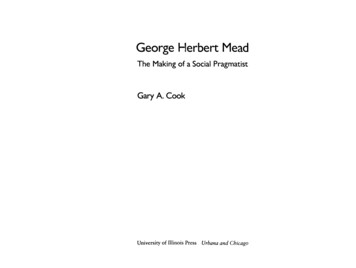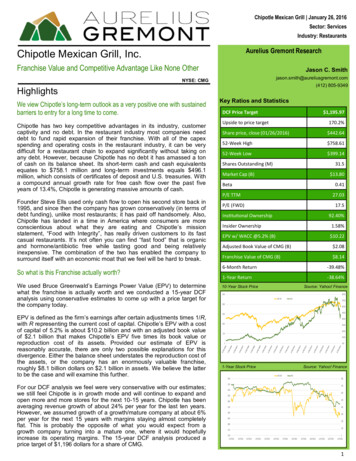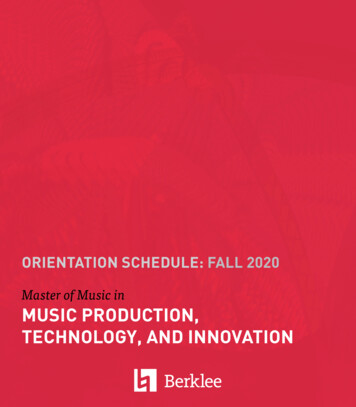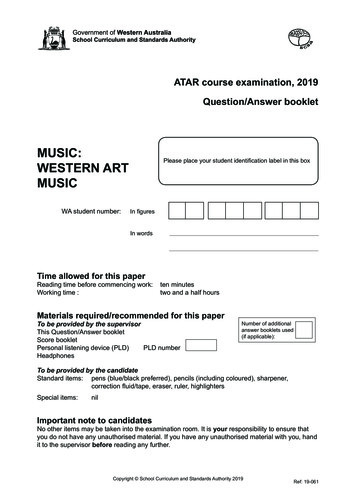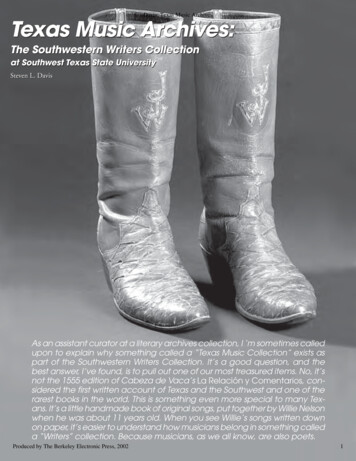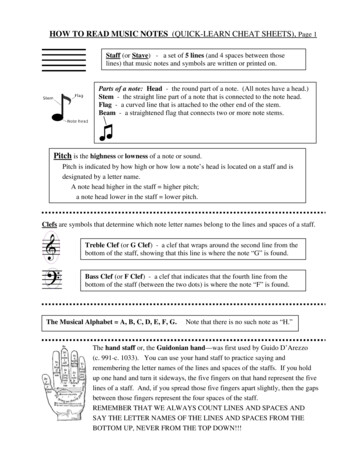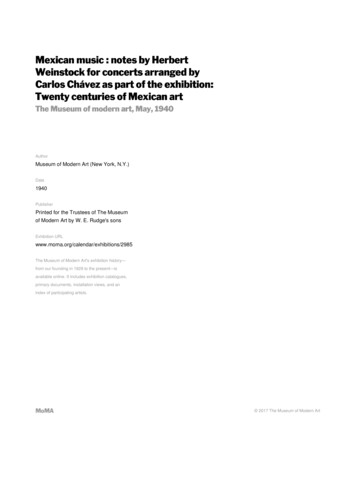
Transcription
Mexican music : notes by HerbertWeinstock for concerts arranged byCarlos Chávez as part of the exhibition:Twenty centuries of Mexican artThe Museum of modern art, May, 1940AuthorMuseum of Modern Art (New York, N.Y.)Date1940PublisherPrinted for the Trustees of The Museumof Modern Art by W. E. Rudge's sonsExhibition URLwww.moma.org/calendar/exhibitions/2985The Museum of Modern Art's exhibition history—from our founding in 1929 to the present—isavailable online. It includes exhibition catalogues,primary documents, installation views, and anindex of participating artists.MoMA 2017 The Museum of Modern Art
MEXICAN MUSICTHE MUSEUMOF MODERNMAY 1940ART
LIBRARYTHE MUSEUMOF MODERN ARTReceived:iMEXICAN MUSICNOTES BY HERBERT WEINSTOCKCONCERTSARRANGEDFORBYCARLOS CHAVEZAS PART OF THE EXHIBITION:TWENTYCENTURIESOFMEXICAN ARTTHE MUSEUM OF MODERN ART MAY, 1940
Teponaxtleof Tlaxcala,from the NationalMuseum of Mexico
vtift106 c.XPROGRAMWith an orchestra especially assembled, and a chorus from the National Music League.CONDUCTORS:May 16, 17, 18 (evenings ) — Carlos ChavezMay 17, 18 (afternoons) and May 19 through May 29(afternoons & evenings) — Eduardo HernandezAfternoons: 2:30 o'clockMoncadaEvenings: 8:45 o'clockPAGEI. Xochipili-MacuilxochitlinstrumentsII. SonesIII.(XVIth— Jalisco— arrangedfor orchestrafor orchestra— arranged(XlXthCancionVII. La PalomaAzulorchestraYaquiMusicorchestraIX. Los CuatroHuizarfor orchestraorchestraChihuahuaby Carlos ChavezBaqueiro— arrangedFoster .19forby Carlos Chavez(traditional)19XlXth, XXth centuries)by Geronimo— (traditional)1517— arranged23forby Luis SandiSoles.— Don Jose Aldana— Zacatecas , Durango,for orchestra— Sonora14(XlXth, XXth centuries )century)— arrangedand chorusXXth centuries)and chorus by Vicente Mendoza— Vera Cruz (XVIIIth,— arranged13by Bias Galindoby Candelariocentury)VI. HuapangosVIII.(XlXtli,— Mexico City (XVIIItha, Vals,— Carlos Chavez— Michoacdn— arrangedV. Marchcentury)MariachiCorridosMexicanosIV. Mass— music for pre-Conquest23— two dances from the ballet, forand chorus(1925) — Carlos Chavez27
Acknowledgments and NotesThe collecting and arranging of the music for these concerts were made possible by agrant from the Rockefeller Foundation.The notes are based on materialCarlos Chavez,The programBias Galindo,will be broadcastNBC Blue hookup,generouslyCandelariosuppliedHuizar,on May 19th; this broadcastof phonographThe photographsBravo.The Hammonddios, HammondCBS networkrecordsof the programbroadcastand Europe.is projected.Organ is furnished through the courtesy of the HammondBuilding, 50 West 57th Street, New York City.Mr. DanielCastanedaof thefrom 10:30 to 11:00 P.M.on pages 2, 13, 16, 18, 20, 22, 24, 28 and 30 are by ManuelWe wish to thankFoster,and Luis Sandi.A specialwill go by short wave to Latin AmericaWe wish to thank Mr. Lincoln Kirsteinboth these concerts and this book.ancient Mexicanthe reproductionBaqueiroMendoza,from 9:00 to 10:00 P.M., May 16th, by WJZ on a nationaland by short wave to Latin America.concert will be heard on WABC and a nationalAn albumby GeronimoVicentefor his generousassistancefor assistancein obtainingAlvarezOrgan Stuin connectionwithreproductionsinstruments;and the National Museum of Mexico for cooperatingof special instruments used at these concerts.ofinTrustees of the MuseumStephenC. Clark,ChairmanSamuel A. Lewisohn,Barr,Jr., Vice-President;Treasurer;Mrs. RobertFord, Philipof the Board;2nd Vice-Chairman;JohnHay Whitney,E. Abbott,Vice-President;Woods Bliss, Mrs. W. Murray1st Vice-Chairman;President;Mrs. JohnCrane, MarshallL. Goodwin, A. Conger Goodyear, Wallace K. Harrison,Henry R. Luce, WilliamS. Paley, Mrs. John Parkinson,Stanley Resor, Mrs. John D. Rockefeller,Jr., BeardsleyHonoraryTrustees:Frederic Clay Bartlett,Mrs. Rainey Rogers, Paul J. Sachs.COPYRIGHTJohnNelson A. Rockefeller,FrankAlfred H.S. Sheppard,Field, Edsel B.Mrs. David M. Levy,Jr., Mrs. Charles S. Payson, Mrs.Ruml, EdwardCrowninshield,1940 BY THE MUSEUM OF MODERN ART, NEW YORK. PRINTEDIN THE UNITEDM. M. Warburg.DuncanPhillips,STATES OF AMERICA
INTRODUCTIONIn the programdetailedof these concertsas possible,Mexicanarts throughselection.In makingprogram;readerI have triedto presentof the music of Mexico. It is necessarilythan that of the usual concert,a period of twenty centuries.Our first problem,may decide as to how completeBefore Europeansarrivedgeneral,archeologyalreadythere flourishedand historyof each of the known culturesas it is possible to define separateics. This does not necessarilycharacteristicsin architecture,achieved.sculpture,of specialand ceramhave ceased to exist,religion,theproofs that theIt is thereforeevident thatof their precursors.the marks of a true artistic culture.in government,andspecific musical charThere are irrefutabletheir musical development.Among the Aztecs, music achievedand was the objectto understandToltec, Maya, etc.) in the same waywas left to them as part of the general cultureof real social importanceof the mathem. On the other hand, we do know preciselydegree of progress which Aztec cultureAztecs did not wholly originatedevelSo that thein Mexico civilizationsare learningmean that such musical characteristicsbut only that we do not recognizetheir musical culture(Archaic,of theour selection has been,relate to each other. I do not believe that anyone could separateacteristicsof the historicmentioned.or imperfectall thethen, was one ofof the extent and profundityon this continent,which present-daybrieferthat includesdesire was to give some conceptionhe must first have a notion, howeverterial which was at our disposal.or culturesa short program,but asfirst the purely musical interestof music in Mexico during the twenty centuriesand listeneran idea, generalfor it must fit into an exhibitionour choices, we consideredour second insistentopmentby Carlos ChavezIt filled a roleand war. It was a true state institution,study and cultivation.In his MonarquiaIndiana,FrayJuan de Torquemada,a Spanish missionary of the XVIth century, wrote a vivid description, from which I quote certain salient points:One of the principal things which they had in all this land was Songs and Dances, as much to solemnifythe Fiestas of their Demons as to honor Gods whom they thought to honor in this manner and for theirown joy and solace. For this reason, and because it was a thing on which they counted much in eachVillage, each Gentleman in his house had a Band of Musicians, with its Singers, its composers of Dancesand Songs, and these, in order to show their imagination,tried to know how to arrange Songs in theirmanner of Meters or Couplets. And when they were good, they were kept very busy, as the Gentlemen in their Houses on many days sang in a subdued voice. Ordinarilyprincipalthey sang and danced in theFiestas, which took place every twenty days, and in others of less importance.of most importancewere in the Plazas, other times in the house of the most importantThe DancesGentleman, in5
his patio, for all the Gentlemen had great patios; they danced also in the houses of other Gentlemenand Leaders. When they had won some victory in War, or created a new Gentleman, or married someimportantLady, or for any other occasion, the Masters composed a new Song, in addition to the usualones which were used in the Fiestas of the Demons and of ancestral deeds. The Singers, some Daysbefore the Fiesta, foresaw what they would have to sing. In the large Villages there were many Singers,and if there were any new songs or dances others joined them so that there would be no flaw on the dayof the Fiesta. The Day they had to dance, the first thing in the morning they put a great mat in themiddle of the Plaza, where the Instrumentswere placed, and all the musicians robed themselves in theHouse of the Gentleman, and came out singing and dancing. Sometimes the Dances began in the morning, and sometimes at the hour which is now that of High Mass, and at night they went around the Palacesinging, and there they ended the song, and sometimes they Danced far into the night, even up to midnight. There were two Instruments.One was high and round, thicker than a Man, about five hands highof very good wood, hollow and elaboratelythis Instrumentcarved. It was painted on the outside. Over the opening ofthey placed the skin of a Deer which had been cured, and was stretched from the edgetowards the middle. They stretched and pressed this in certain places to make the higher and lower tones.This Instrumentplayed in tune with the singers. The other Instrumentwas so elaborate that I cannotexplain it to you without painting it. This served as a contrabass, and they both sounded well, and youcould hear them from a great distance. When the Dancers arrived at the place, they put themselves inorder to play the Instruments. The two best singers, as Leaders, then began the song. The large Drum wasplayed with the hands, and this one was called a Huehuetl. The other, being made differently, was playedwith sticks like the Instrumentsother Principalsof Spain, and this one was called the Teponaztli. The Gentleman, andand Old men, went in front of the Instruments,dancing and singing. Around themanother circle formed and increased the chorus. Those who moved thus in the big Villages were sometimes more than a thousand, and even sometimes more than two thousand. In addition, on the outsidethere was a processionof two kinds of Youths, great Dancers. The ones heading the dance were twoMen alone, the best dancers, guiding the Dance. In these two circles, in the course of some turns theymade, they sometimes found themselves facing members of the other circles. In other Dances, they movedwith the one next to them or behind them. There were so many of these two groups of dancers thatsometimes there were almost a thousand of them, and sometimes more, depending on the Villages andthe Fiestas. In ancient times, before the Wars, when they celebratedtheir festivals with freedom, sometimes in the large Towns three or four thousand or more joined the dance, though now the populationhas diminished,and very few join in the dance. Wishing to begin the dance, three or four Indians raisevery shrill whistles, then the Instrumentssound in a low tone, and little by little increase in volume.When the dancing People hear that the Instrumentshave begun, they understandfrom the tone the kindof song and dance, and they begin. The first Songs go slowly and in a deep tone. The first is according tothe liesta, and is always started by the two Leaders. Then the whole Chorus takes it up jointly with theDance. This enormous group of people keeps such perfect time as do very dexterous Dancers in Spain,and what is more the whole body, the head, arms, and hands are so much in unison that there is nodiscrepancy of beat. If one dancer makes a step with the right foot and then the left foot, they all do thesame thing and in exactly the same way. In the same manner the Instruments,the Song, and the Dancersare all in time. There is not a discrepancy. When some very good Spanish Dancers have seen this, theyhave despaired. And even the ones on the outside farther away, those who keep the rhythm, and the oneswho work hardest in the Dance are all in unison. Those in the middle do their part more simply andtheir movements of the feet and body are more serious. And certainly they raise and lower their armswith much grace. Each Verse or Couplet is repeated three or four times, and they keep moving and6
pronouncingtheir Song so well intoned that there is no discord. When one Song is finished, seeing thatthe first ones seem the longest because they go most slowly, though none of them lasts more than an hour,as soon as the Instrumentchanges tone, when all cease the Chant and when certain intervals have beenmade (in the Song but not in the dance) then the Leaders begin another Chant, a little higher and morelively. In this way the Songs keep rising and the sounds keep changing, as though someone changedfrom a bass to a tenor voice, or from a dance to a counter-beat. There are also some Boys who follow thedancing, the Children of the principal men, usually seven or eight years old, and sometimes four or fiveyears old. They sing and dance with the Fathers, and as the Boys sing in a very high voice or falsettothey improve the singing very much. Sometimes these play their own Trumpets and little Flutes withfew tones. Others whistle with bone whistles which make a lot of noise. Others go disguised in costumeand voice, travestying other Nations and their languages. Those of whom I speak are Clowns and theymake themselves conspicuous, making faces and jesting, and they make those who see and hear themlaugh a great deal. Some of them imitate old women, others imitate fools. Sometimes drinks are broughtto the dancers. Then some go out to rest and eat, and others take their places. In this way all are ableto rest without stopping the Dance. Sometimes they bring Bunches of Roses and other Flowers or smallBouquets to carry in their hands, and Garlands which they place on their heads, in additioncostumes they use for the dance —elaborateto theMantles and plumage. Still others carry in their handsinstead of Bouquets beautiful small Plumage. In these dances they wear many decorations and emblemswhich show which ones have been valiant in war. From the hour of vespers until night the Dances andSongs keep getting more lively and the volume gets greater all the time. The sound is more graceful,so that it seems almost like Hymns of happiness. The Instrumentsalso increase in volume, and as thereare many people dancing, it is heard far and near, especially when the Air carries the voice, and evenmore during the night, when everything is subdued. In order to dance at this time, they use many Lights,and certainly it is something to see.Among the Aztecs music also played a purely lyric part. Fray BernardinopreservedAztec poetry which tells us of the contemplativethe Indianmusic and
detailed as possible, of the music of Mexico. It is necessarily a short program, briefer than that of the usual concert, for it must fit into an exhibition that includes all the Mexican arts through a period of twenty centuries. Our first problem, then, was one of selection. In making our choices, we considered first the purely musical interest of the
